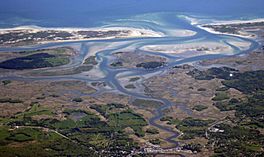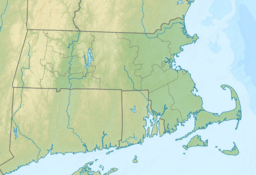Great Marsh facts for kids
Quick facts for kids Great Marsh |
|
|---|---|
| Great Salt Marsh | |

|
|
| Location | |
| Coordinates | 42°44′07″N 70°49′08″W / 42.735277°N 70.818914°W |
| Type | Saltmarsh |
| River sources | Parker River |
| Ocean/sea sources | Atlantic Ocean |
| Surface area | 20,000–30,000 acres (8,100–12,100 ha) |
| Salinity | Salt Water |
| Frozen | Salt water Lake |
| Islands | Plum Island |
| Settlements |
|
The Great Marsh (also called the Great Salt Marsh) is a huge, continuous saltmarsh area. It stretches along the coast of New England. You can find it from Cape Ann in northeastern Massachusetts up to the southeastern coast of New Hampshire.
This amazing natural area covers about 20,000 to 30,000 acres. It includes saltwater marshes, mudflats, islands, and sandy beaches. You'll also see dunes, rivers, and other water bodies here. The Great Marsh covers a big part of Essex County, Massachusetts. It touches towns like Essex, Gloucester, Newburyport, Newbury, Rowley, Ipswich, and Salisbury in Massachusetts. It also reaches Seabrook and Hampton in New Hampshire. It's known as an Important Bird Area.
Contents
What is a Salt Marsh?
A salt marsh is a special type of wetland. It's found along coasts in areas protected from strong waves. These areas are often flooded by ocean tides. This means the water is salty, unlike freshwater marshes.
Salt marshes are full of unique plants. These plants can handle growing in salty water. They have special ways to get rid of extra salt. The ground in a salt marsh is usually soft and muddy.
How Salt Marshes Form
Salt marshes usually form in sheltered places. These include bays, estuaries, and behind barrier islands. Rivers carry sediment, like mud and sand, into these areas. The calm water allows the sediment to settle.
Over time, layers of sediment build up. This creates a flat, muddy area. Special grasses then start to grow there. Their roots help to hold the soil together. This allows more sediment to collect.
Life in a Salt Marsh
Salt marshes are very important ecosystems. They are home to many different animals. These include birds, fish, crabs, and insects. Many animals use the marsh as a nursery. Young fish and crabs hide from predators here.
The marsh provides plenty of food. It's a great place for birds to find insects and small fish. Many migratory birds stop here to rest and feed. They rely on the marsh during their long journeys.
Why the Great Marsh is Important
The Great Marsh is one of the largest salt marshes in New England. Its size makes it incredibly valuable. It plays many important roles for both nature and people.
Protecting the Coast
Salt marshes act like natural sponges. They soak up extra water during storms and high tides. This helps to protect the land behind them from flooding. They also reduce the power of waves. This stops the coastline from eroding away.
The dense roots of marsh grasses hold the soil firmly. This prevents mud and sand from washing into the ocean. It keeps the coastline stable and healthy. This protection is very important for coastal communities.
A Natural Filter
Salt marshes also work as natural filters. They help clean the water that flows through them. The plants and soil trap pollutants and excess nutrients. This keeps the ocean water cleaner.
This filtering process is vital for marine life. Cleaner water means healthier fish and shellfish. It also helps other coastal habitats, like oyster beds.
Home for Wildlife
The Great Marsh is a critical habitat. It supports a wide variety of animals. Many species depend on the marsh for their survival.
- Birds: It's a key stop for many migratory birds. You can see herons, egrets, ospreys, and various shorebirds. It's an Important Bird Area because so many birds use it.
- Fish: Many fish species use the marsh as a nursery. Young fish like flounder and striped bass grow up here. They find food and shelter among the grasses.
- Crabs and Shellfish: Fiddler crabs, blue crabs, and various types of shellfish thrive in the muddy bottom. They are an important food source for other animals.
- Mammals: Smaller mammals like muskrats and raccoons also live in and around the marsh. They feed on the plants and animals found there.
A Place for Learning and Fun
The Great Marsh is also a wonderful place for people. It offers opportunities for outdoor activities. You can go birdwatching, kayaking, or hiking. Many people enjoy exploring its natural beauty.
It's also a living classroom. Scientists study the marsh to learn more about coastal ecosystems. Students visit to understand how salt marshes work. Protecting this area helps us learn more about our planet.
Protecting the Great Marsh
Because the Great Marsh is so important, many groups work to protect it. Conservation efforts focus on keeping the marsh healthy. This includes monitoring water quality and protecting wildlife.
It's important to keep pollution out of the marsh. We also need to manage human activities carefully. This ensures that this amazing natural area will be here for future generations. Everyone can help by being mindful of their impact on coastal environments.


